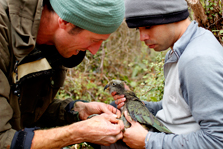Possums eat kea
 Friday, November 19, 2010 at 9:25
Friday, November 19, 2010 at 9:25 New evidence shows possums are eating New Zealand's native parrot the kea. Researchers using nest-cameras have for the first time witnessed the gruesome reality inside defenceless kea nests invaded by stoats and possums in South Westland.
Brent Barrett, from the Department of Conservation, says large numbers of kea nests are failing in the wild but it is only now that camera equipment has been able to uncover what's going on.
"We are just midway through the breeding season and of eleven nests we've had under surveillance three have been devastated by stoats and possums. That's a loss of six chicks."
Mr Barrett said photos and videos have been posted on YouTube under the key words "possums eat parrots" so that people can see for themselves exactly what is going on in kea nests.
"We have never been able to look at kea nests in this way before and it was a grisly surprise to see photos of a possum eating a nearly fledged kea and video showing the prolonged and tormented death of chicks attacked by stoats," Mr Barrett said.
"Possums have previously been filmed killing an adult kaka but until now we were completely unaware of their direct impact on kea nests," he said.
"This constitutes a huge risk to our lowland populations as nearly all of our nests are being visited by possums."
 Josh Kemp and Troy Makan attach a transmitter to a young kea Mr Barrett said it has been distressing to discover that just how long it takes chicks to die during a prolonged attack by stoats.
Josh Kemp and Troy Makan attach a transmitter to a young kea Mr Barrett said it has been distressing to discover that just how long it takes chicks to die during a prolonged attack by stoats.
"One attack lasted two and a half hours with the stoat remaining in the recesses of the nest hole and repeating its assault on the two dying chicks. One chick died at the end of the torment but the other lived for 40-hours with its injuries before disappearing. The mother was also injured"
The stoat predation footage was captured at a nest south of Fox Glacier and the possum was photographed in Okarito Forest.
"The YouTube footage is unpleasant stuff to watch, but it shows what's going on in places where predators are not controlled," Mr Barrett said.
The kea research team is monitoring nests in the Okarito Forest and in the area from the Copland Valley to the Paringa River, south of Fox Glacier. These areas are steep and thickly forested making it difficult to track wild kea and carry camera equipment and large batteries around in.
"We are all relieved that the effort is worth it, but saddened by the graphic nature of what we have found," Mr Barrett said.
Researchers are also monitoring trees for signs of excessive fruiting which would trigger a chain of events starting with a rat plague and ending with a plague of stoats.
"We are still in the process of gathering this information, but at the moment it looks like we may have a moderate rimu fruiting coming up," Mr Barrett said.
 Nestor notabilis - Kea | in
Nestor notabilis - Kea | in  Conservation,
Conservation,  Introduced predators
Introduced predators 

